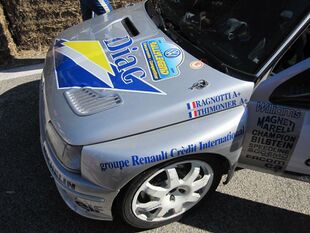Engineering:Clio Williams Maxi
| Renault Clio Williams MAXI | |
|---|---|
 | |
| Overview | |
| Manufacturer | Renault Sport |
| Production | 1995-1996 with later evolutions |
| Body and chassis | |
| Class | Rally car |
| Body style | 3-door hatchback |
| Related | Renault Mégane Maxi Peugeot 306 Maxi Peugeot 106 Maxi Citroen ZX Maxi Seat Ibiza Kit car Fiat Punto Kit car |
| Powertrain | |
| Engine | 2.0 L Naturally aspirated I4 |
| Transmission | 6-speed manual or 6-speed sequential (7-speed sequential from Megane Maxi can be retrofitted) |
The Clio Williams Maxi is a factory evolution of the Clio Williams Gr. A rally car introduced in early 1995 under kit-car rules (Gr.A7K). It was used to represent the brand in various national championships such as the French Rally Championship in France in the hands of Philippe Bugalski and Jean Ragnotti, the Belgian Rally Championship in Belgium with Bernard Munster, and in the British Rally Championship with Alain Oreille and Robbie Head, with the French and British rally teams also competing in the World Rally Championship. The most notable exterior differences are wider wheel arches to accommodate bigger wheels and wider track, different front and rear bumpers and a carbon fibre rear wing.
Other exterior differences are another bonnet vent for dissipating heat from the engine bay and fuel cap in a different location. The most commonly used rims were Speedline 2012 "Acropoli Due" and Speedline 2010 (used mostly on the front wheels). Rims were made from magnesium and were 16″ or 15″ for gravel and 17″ for tarmac stages.
Suspension (3-way adjustable) was made by Proflex and track was widened to 1590 mm. The Maxi had much thicker anti-roll bars (up to 35 mm for tarmac stages). Hubs were made of aluminium and were bespoke items. Rear beam was also modified with thicker ARB and allowed different camber and toe settings.
Brakes were made by Alcon. Front discs were on aluminium bells and were 332 mm in diameter with 4 pot Alcon calipers. Rear discs were 266 mm in diameter with 2 pot Alcon calipers.
Roll Cage and shell reinforcements were done by Matter France.
The F7R engine was tuned by Sodemo and produced around 250 hp in early evolutions (around 275 hp for last evolutions with a destroked engine). The main difference to the Gr.A car was the use of individual throttle bodies and even wilder cams. Other differences include modified head for improved gas flow and modified block for better cooling. Extremely wild cams with maximum lift up to 15 mm required the use of solid lifters and titanium valves, springs and retainers. Pistons and rods were made by Pankl. Pistons were a forged "slipper" design and rods were forged H section with custom 150 mm length to compensate for different piston compression height. Compression ratio was 12.5:1 and ran on special racing fuel. Exhaust manifold was a 4-2-1 design and was made from Inconel alloy. Clutch was made by AP Racing.
Transmission was either a 6-speed Sadev manual or 6-speed RST Hewland sequential gearbox (7-speed sequential gearbox from the Megane Maxi can be retrofitted, but is not homologated). The Clio Maxi was one of the first, if not the first, rally cars with a sequential gearbox.
The interior featured an instrument panel made by Stack and Magnetti Marelli, seats were made by Sabelt or Sparco. By 1996, when the Clio Williams Maxi's successor came out (Megane Maxi), 50 cars were made.
More cars were made from kits, and sold direct to the customer.
This article does not cite any external source. HandWiki requires at least one external source. See citing external sources. (2021) (Learn how and when to remove this template message) |
 |

